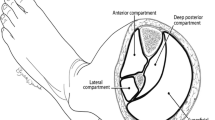Abstract
The actual pathology of the Nicolau syndrome (NS) is still unknown. It is thought to involve direct vascular damage and vasospasm. Many NS cases were reported in the literature but a treatment protocol is still not established. However, after demarcation of the necrotic tissue, surgical intervention is mandatory. Five NS cases with extensive tissue necrosis on the upper lateral gluteal region were analyzed retrospectively. Operative technique was described in details for freestyle perforator-based fasciocutaneous flaps from the gluteal region to reconstruct defects of NS-related tissue necrosis. Freestyle perforator-based fasciocutaneous flaps were used for defect closure in all patients. All flaps survived totally. No complications occurred during the follow-up period. Although rare, NS is a serious complication of inadvertent intramuscular injections. Prevention is the best treatment. However, in case of large-tissue necrosis, freestyle perforator-based fasciocutaneous flaps harvested from the gluteal region is a satisfactory option for reconstruction.

Similar content being viewed by others
References
Corazza M, Capozzi O, Virgilit A (2001) Five cases of livedo-like dermatitis (Nicolau’s syndrome) due to bismuth salts and various other non-steroidal anti-inflammatory drugs. J Eur Acad Dermatol Venereol 15(6):585–588
Lie C, Leung F, Chow SP (2006) Nicolau syndrome following intramuscular diclofenac administration: a case report. J Orthop Surg (Hong Kong) 14(1):104–107
Luton K, Garcia C, Poletti E et al (2006) Nicolau syndrome: three cases and review. Int J Dermatol 45:1326–1328
McGee AM, Davison PM (2002) Skin necrosis following injection of non-steroidal anti-inflammatory drug. Br J Anaesth 88(1):139–140
Hamilton B, Fowler P, Galloway H et al (2008) Nicolau syndrome in an athlete following intramuscular diclofenac injection. Acta Orthop Belg 74(6):860–864
Nischal K, Basavaraj H, Swaroop M, Agrawal D, Sathyanarayana B, Umashankar N (2009) Nicolau syndrome: an iatrogenic cutaneous necrosis. J Cutan Aesthet Surg 2(2):92–95
Uri O, Arad E (2010) Skin necrosis after self-administered intramuscular diclofenac. J Plast Reconstr Aesthet Surg 63(1):e4–e5
Cherasse A, Kahn MF, Mistrih R et al (2003) Nicolau’s syndrome after local glucocorticoid injection. Joint Bone Spine 70(5):390–392
Koklu E, Sarici SU, Altun D et al (2009) Nicolau syndrome induced by intramuscular vitamin K in a premature newborn. Eur J Pediatr 168(12):1541–1542
Ocak S, Ekici B, Cam H et al (2006) Nicolau syndrome after intramuscular benzathine penicilin treatment. Pediatr Infect Dis J 25(8):749
Gayken J, Westanmo A, Knutsen A et al (2006) Livedoid dermatitis and severe necrosis (Nicolau’s syndrome) after intramuscular hydroxyzine injection. J Burn Care Res 27(4):541–544
Erkek E, Tuncez F, Sanli C et al (2006) Nicolau’s syndrome in a newborn caused by triple DTP (diphtheria-tetanus-pertussis) vaccination. J Am Acad Dermatol 54:S241–S242
Kienast AK, Mentze D, Hoeger PH (2008) Nicolau’s syndrome induced by intramuscular vaccinations in children: report of seven patients and review of the literature. Clin Exp Dermatol 33:555–558
Bravo FG, Schwarze HP (2009) Free-style local perforator flaps: concept and classification system. J Plast Reconstr Aesthet Surg 62(5):602–608
Okan G, Canter HI (2010) Nicolau syndrome and perforator vessels: a new viewpoint for an old problem. Cutan Ocul Toxicol 29(1):70–72
Marangi GF, Gigliofiorito P, Toto V et al (2010) Three cases of embolia cutis medicamentosa (Nicolau’s syndrome). J Dermatol 37(5):488–492
Park HJ, Kim MS, Park NH et al (2011) Sonographic findings in Nicolau syndrome following intramuscular diclofenac injection: a case report. J Clin Ultrasound 39(2):111–113
Sarifakioglu E (2007) Nicolau syndrome after diclofenac injection. J Eur Acad Dermatol Venereol 21(2):266–267
Panariello L, Ayala F (2008) Nicolau syndrome following intramuscular diclofenac injection: a case report. Dermatol Ther 21(Suppl 1):S10–S12
Kim KK (2011) Nicolau syndrome in patient following diclofenac administration: a case report. Ann Dermatol 23(4):501–503
Ezzedine K, Vadoud-Seyedi J, Heenen M (2004) Nicolau syndrome following diclofenac administration. Br J Dermatol 150:385–387
Geukens J, Rabe E, Bieber T (1999) Embolia cutis medicamentosa of the foot after sclerotherapy. Eur J Dermatol 9(2):132–133
Sen S, Chini EN, Brown MJ (2005) Complications after unintentional intra-arterial injection of drugs: Risks, outcomes, and management strategies. Mayo Clin Proc 80:783–795
Senel E, Ada S, Güleç AT et al (2008) Nicolau syndrome aggravated by cold application after i.m. diclofenac. J Dermatol 35(1):18–20
Meltem C, Esra C, Hasan F et al (2004) The gluteal perforator-based flap in repair of pressure sores. Br J Plast Surg 57(4):342–347
Coşkunfirat OK, Ozgentaş HE (2004) Gluteal perforator flaps for coverage of pressure sores at various locations. Plast Reconstr Surg 113(7):2012–2019
Yildirim S, Taylan G, Aköz T (2007) Freestyle perforator-based V-Y advancement flap for reconstruction of soft tissue defects at various anatomic regions. Ann Plast Surg 58(5):501–506
Seyhan T, Ertas NM, Bahar T et al (2008) Simplified and versatile use of gluteal perforator flaps for pressure sores. Ann Plast Surg 60(6):673–678
Chan VO, Colville J, Persaud T, Buckley O, Hamilton S, Torreggiani WC (2006) Intramuscular injections into the buttocks: are they truly intramuscular? Eur J Radiol 58(3):480–484
Conflict of Interest
Emre A. Kocman, Fatih N. Yaşar, Aydan A. Kose, Yakup Cil, Yakup Karabagli, and Cengiz Çetin declare that they have no conflict of interest.
Author information
Authors and Affiliations
Corresponding author
Rights and permissions
About this article
Cite this article
Kocman, E.A., Yaşar, F.N., Kose, A.A. et al. Freestyle Perforator-Based Fasciocutaneous Flap Reconstruction in Nicolau Syndrome-Related Tissue Necrosis. Indian J Surg 77 (Suppl 3), 1187–1190 (2015). https://doi.org/10.1007/s12262-015-1239-2
Received:
Accepted:
Published:
Issue Date:
DOI: https://doi.org/10.1007/s12262-015-1239-2




